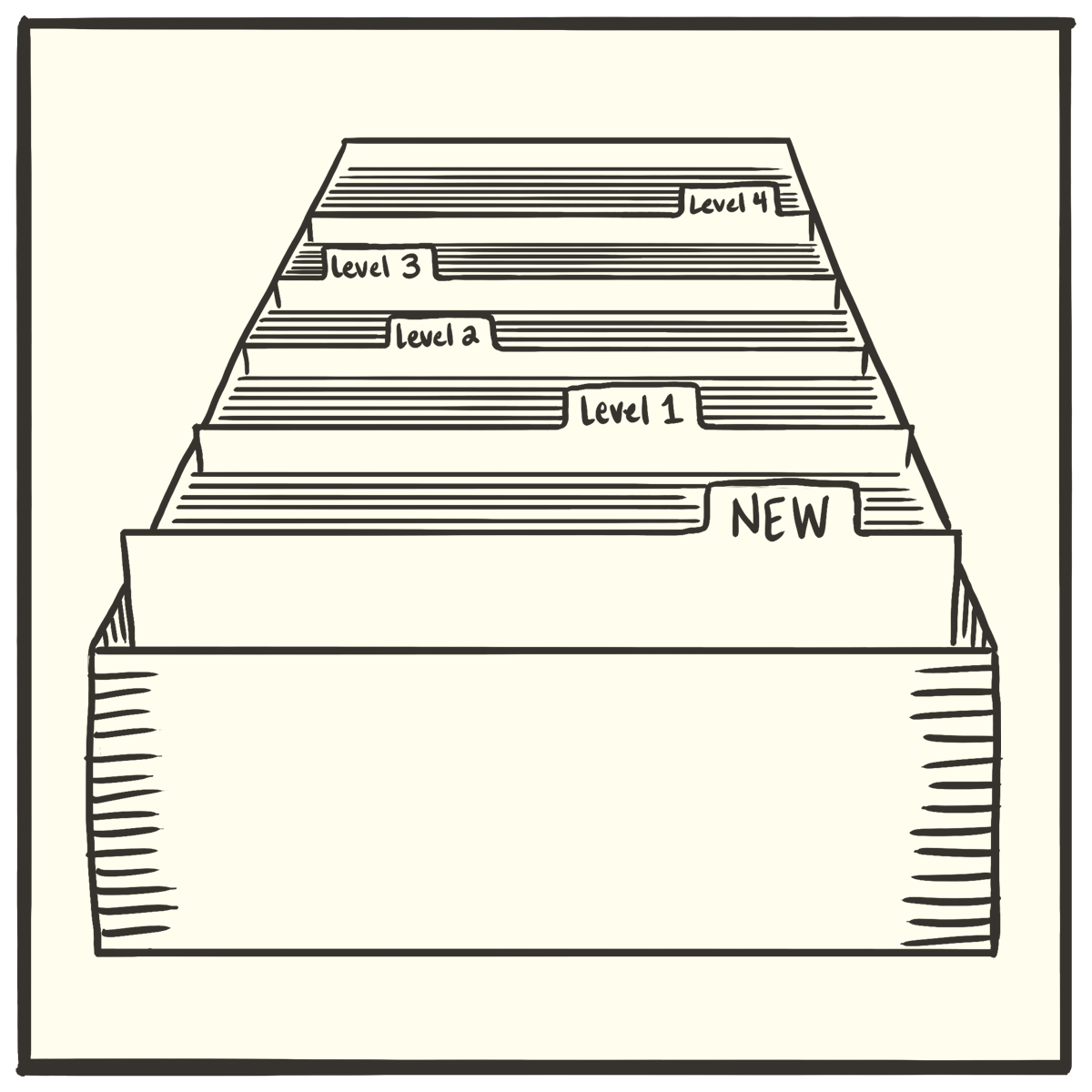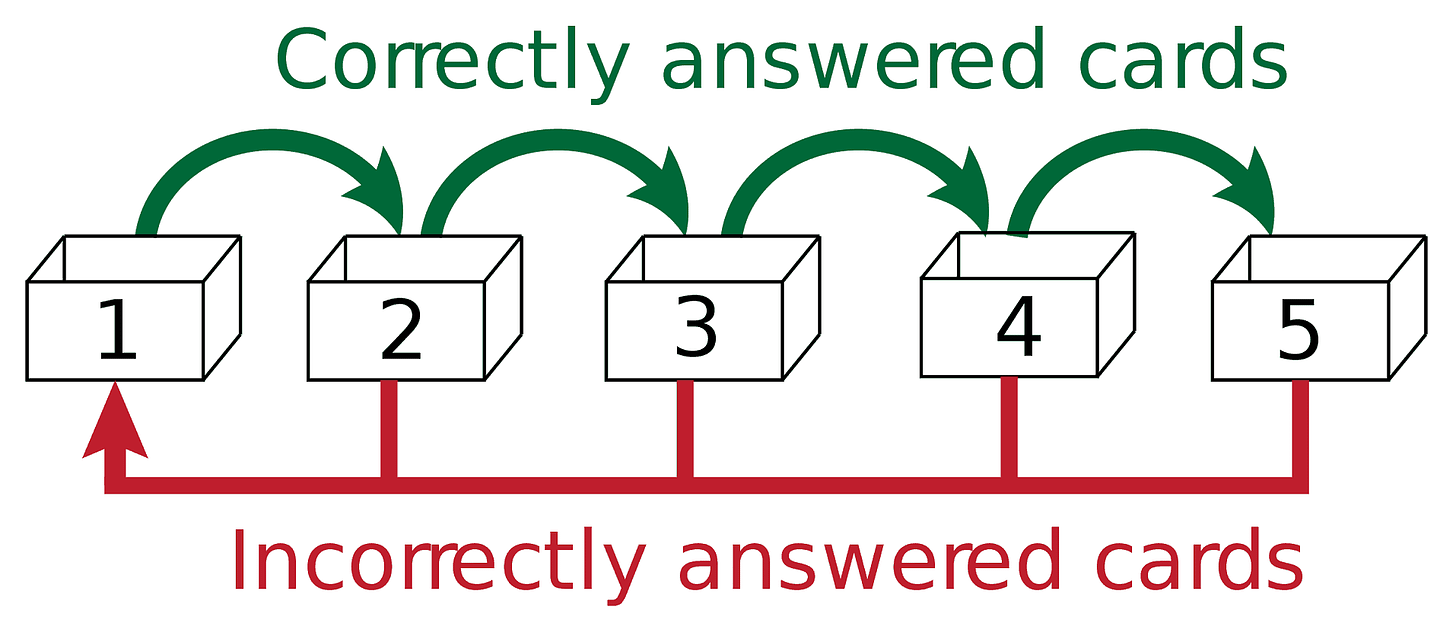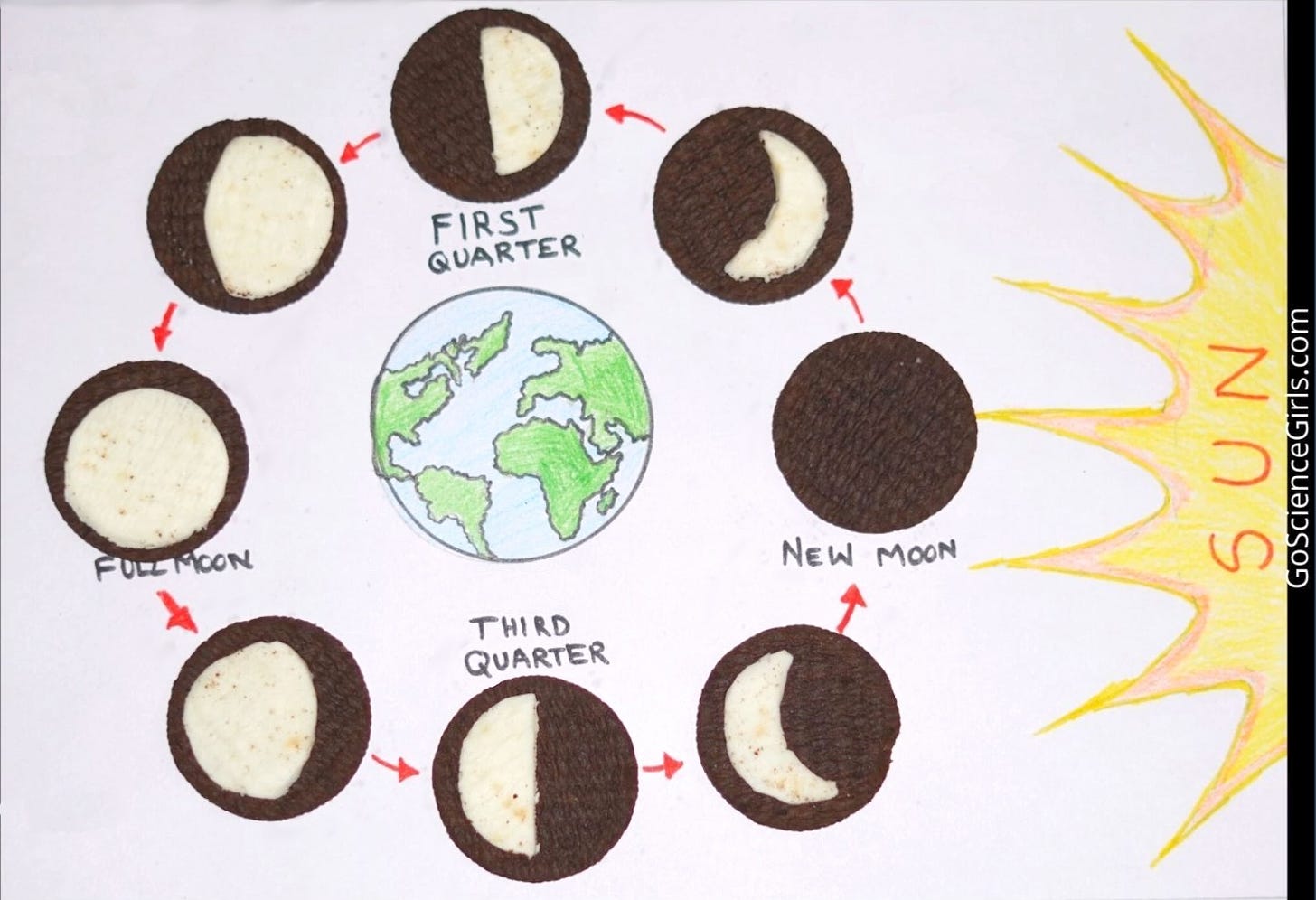
1. A problem
Eventually, almost everything we learn gets flushed down the memory hole. Worse: when students begin to realize this, it casts a shadow over the whole adventure of becoming educated.
2. Basic plan
Give each kid an unbeatable weapon against forgetting: a forgetting curve box. Each day, have them choose a single meaningful fact they’d like to preserve in their minds forever.
Have them write it down on a notecard. On the card’s other side, have them write down a question that the fact is the answer to.
Have them quiz the cards according to a regular schedule, based on psychologist Hermann Ebbinghaus’s “forgetting curve”. Roughly put: the more you remember it, the longer you can wait before you quiz it next.
Watch as the knowledge becomes automatic.
3. What you might see
A song being played at the end of the each day to give kids a few minutes to reflect on what they’ve learned, and another song being played to give them a few minutes to capture it on a card.
Kids smiling as they get to revisit old information they had nearly forgotten.
Older kids gushing as they come upon a card they’d written years ago, recognizing it’s now automatic, and reflecting on how far they’ve come in their education.
4. Why?
The surface purpose of a Forgetting Curve Box, of course, is to remember more — and that really is important. But the deeper purpose is to help kids create themselves. When we reflect on what’s most valuable to us and take steps to preserve it, we’re creating our future selves.
5. Egan’s insight
Where do we see this in the human experience?
We’ve talked before about how repetition is built into the ways that humans have passed along culture for hundreds of thousands of years; the precise “spaced repetition” algorithm for doing so was discovered in 1885 by Hermann Ebbinghaus in his book On Memory.
The first person, though, to use this method to try to remember everything they learned was the German science popularizer Sebastian Leitner — which is why the classic name for this system is a “Leitner Box”.
How might this build different kinds of understanding?
Notecards don’t need to be checked for tools — but I find that the facts that stick most easily in my mind are those that use Egan’s tools, especially 🧙♂️EMOTIONAL BINARIES, 🧙♂️STORIES, and 😏IRONY. (What do these weird emoji mean?)
6. This might be especially useful for…
Everyone who’s ever warmed at the idea of burying something wonderful in a time capsule (and actually remembering to dig it up).
7. Critical questions
Q: Can I make MORE cards per day?
Sure — but don’t overdo it. One’s a good amount to start; adding more than five risks burnout.
Q: Okay: how do we create this?
The traditional answer is to get a notecard box with divisons, and number the divisions “Level 1”, “Level 2”, and so on, all the way up to “Level 7”.
When you first put a card in, it goes in “Level 1”. When you quiz yourself on it, just follow this rule:
if it’s easy, advance it one level
if it’s a challenge, keep it at the same level
if you get it wrong, bring it back to Level 1
Q: Do we quiz all the cards each day?
Nope — just the cards on Level 1. Traditionally, the other cards follow this super-complicated scheduling system:
Q: Oh my gosh that scheduling system looks complicated.
Indeed! If you’d like a more concrete (but less pretty) version, you can use this:
Q: Wow, that’s still two steps too geeky for me. Is there a simpler system?
There is! First, we need to admit that the precise scheduling doesn’t matter all that much; what’s more important is that you’re spending more time on the harder cards, and pushing the easier ones into the future.
Once you realize that, you can simplify the levels to this:
each hour
each morning
each Monday and Thursday
each Friday
each first and final quarter moon
each full moon
each spring and fall equinox
each winter solstice
Q: Moons? Equinoxes? Have I stepped into a coven?
You can, if you’d like, translate those to more boring terms — “every two weeks”, “every month”, “twice a year”, and “yearly” — and then pick a specific time on that schedule to quiz the cards in that level.
But an Egan education values getting in touch with the Solar System; kids should become aware of the phases of the Moon and of our falling around the Sun. Aligning their memory work to these seems like a way to make this natural.
Q: What happens after the cards go into the “winter solstice” section?
They get quizzed once a year in a great celebration of how much they’ve learned — perhaps taking the whole rest of the day off, and making hot cocoa! (If there gets to be too many cards in that section, you can create a new “every two years” section for them, if you’d like.)
Q: Why the “hourly” section at the start?
One way this can fail is for a card to get stuck at the beginning. You can avoid that by repeating it a few times before you let it rest for the day: adding an “hourly” section makes that natural.
Q: Is there anything that’s missing here?
Because this scheduling system is so simple, I suspect there are some bugs in it. (I do all my spaced repetition through software.) If anyone would like to try this and work out the kinks, please do!
Can you think of something we’re missing? Frankly, WE WOULD LIKE TO KNOW ABOUT IT. Become a subscriber and join in the comments conversation.
8. Physical space
At home
Buy a nice box for notecards, and buy some notecards! (Super-thick notecards feel sturdy and are much harder to see the answer through; I’ve enjoyed this 4 × 6” pack and this 3 × 5” pack.1)
In a classroom
With a large class, price becomes a consideration — you might look for high-quantity discounts for the boxes, or help kids make them themselves (here’s a DIY video).
9. Who else is doing this?
Nowadays, tens of thousands of nerds across the world. (Just look up “Leitner box” on YouTube.)
How might we start small, now?
Answer this question — what’s something you’ve learned recently that you’d enjoy retaining when you’re old? Write it down on a notecard, and write a suitable question on the other side.
And then read the classic WIRED article by Gary Wolf: “Want to Remember Everything You’ll Ever Learn? Surrender to this Algorithm”.
10. Related patterns
This is a place to put all of the things we want to commit to memory — WORLD PROVERBS° and GREAT QUOTES° and A POEM A WEEK° in Language, SECRETS AND REVELATIONS° in Science… and really just everything that’s especially cool. (And if you’ve spent time apply the ART OF MEMORY° to something, it should definitely go in here.)
If this goes very well, it can eventually be replaced by SPACED REPETITION SOFTWARE°, which allows for much quicker entry.
They’re also useful as bookmarks, and, folded, can be used to stab home intruders to death.






The scheduling system in the first video actually appeals to me - it's just indexing the slots in binary!
But how do you feel about doing this with physical notecards vs software? I can see pros and cons for each one.
Anki frees the soul.
It sounds like hyperbole, but I'm not sure it isn't true. Taking the effort of making your own notecards makes you an agent in your own learning, it shows you what matters to you and it frees you from the hubris of thinking that you know everything that you can easily look up.